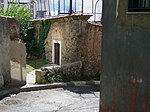Hasköy is a district on the northern bank of the Golden Horn in Beyoğlu, Istanbul, Turkey. It includes the neighborhoods of Keçeci Piri, Piri Paşa, and Halıcıoğlu, and parts of Camiikebir and Sütlüce.
Hasköy means "imperial village" in Turkish, a reference to the pavilions and gardens belonging to the Ottoman sultan and his court once found here. According to other sources, the name is a corruption of Aya Paraskevi, Αγία Παρασκευή, the local Greek Orthodox church.In the late fifteenth century, Jews expelled from Spain and Portugal took refuge in the Ottoman Empire and many of them settled in Hasköy. In the late sixteenth century, the Jewish community of Eminönü was displaced by the construction of the New Mosque (Yeni Cami) and also moved to Hasköy. The neighborhood also had many Armenian and Greek residents in the past. It was known to Armenian speakers as Khasgiugh (Խասգիւղ), "khas" reflecting the older pronunciation of the Turkish word "has" and "giugh" being the Armenian word for village.
Hasköy was a trading area with many dockyards and warehouses.
The first Armenian theatre company in Istanbul was founded here in 1858.Local attractions include the Aynalıkavak Palace and the Rahmi M. Koç Museum.
At one time there were several active synagogues in Hasköy including the Maalem Synagogue, Hesed Le Avraam Synagogue, the Karaite Synagogue and the former Mayor Synagogue.
The Greek Orthodox Church of Aya Paraskevi (Saint Paraskevi) still functions and has been provided by the Ecumenical Patriarchate to the local Romanian Orthodox community. The Surp Stepanos (Saint Stephen) Armenian Church was established by Armenian immigrants from Eğin. From 1852 to sometime in the 20th century, the Halıcıoğlu Armenian Protestant Church also offered services; while from 1889 to 1975, there was also a chapel attached to Hasköy's Kalfayan Orphanage, the Surp Asdvadzadzin (Saint Mary) Armenian Church.Local mosques include the Handan Agha Mosque, and Kırmızı Minare Mosque.
Local cemeteries include the Hasköy Muslim Cemetery, the Beyoğlu Greek Cemetery, the Beyoğlu Jewish Cemetery, the Turkish Karaite Congregation Cemetery, and the Hasköy Armenian Cemetery. The Jewish Cemetery contains the grave of Abraham Kamondo, a banker to the Ottoman court. On April 26, 2011, the cemetery was desecrated by vandals who smashed several headstones in what appears to have been an act of anti-Semitism.










